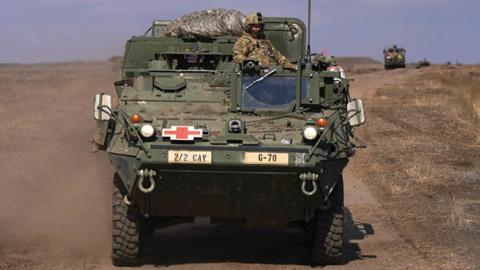The Biden administration is right to try to avoid a direct military confrontation with Russia, but their confrontation avoidance has made the White House dangerously and unreasonably risk-averse. The effect of President Joe Biden’s intense risk aversion cedes the advantage in any intense crisis to the party prepared to threaten escalation— in this case, the Russians. When Biden officials publicly reassure the Russians what they are unwilling to do in Ukraine, the Russians increase their brutality and hit targets closer to NATO’s borders. More than two weeks into the war against Ukraine, Russia is not looking for an off-ramp. The United States must get to work on making Russia look for one.
When Russia was building up forces to invade, the Biden team withheld sanctions to give diplomacy a chance. In response to Russian nuclear saber-rattling, the Biden administration announced that it was exercising “restraint.” It canceled a long-planned intercontinental ballistic missile test, and after a naval incident, a Biden official announced that the U.S. didn't provide Ukraine with intelligence, surveillance, and reconnaissance — lest Russia think we were helping too much. Even when Lithuania and Latvia were sticking their necks out to provide man-portable Stinger missiles to Ukraine, out of fear of being provocative, the U.S. still had not. When Poland went public with its plan to send MiG-29 fighter jets to Ukraine via a U.S. base in Germany, Biden officials publicly rejected it and called the move “high-risk.” And, of course, Biden officials have been very publicly unwilling to consider any version of a no-fly zone. Biden took to Twitter to reiterate that the U.S. “will not fight a war against Russian in Ukraine,” which is compatible with a recent media report that said the White House chose not to send U.S. military trainers to Ukraine in February for fear of provoking Russia.
While Biden officials publicly declare what the U.S. is not doing and will not do to help Ukraine, the Russians respond by expanding their military target list and publicly threatening NATO in new ways. In other words, Biden’s unwillingness to engage at entirely reasonable levels of escalation to support Ukraine and NATO allies is encouraging President Vladimir Putin to escalate. The Russians are hitting civilian targets, and there are reports of other Russian war crimes. Last weekend, Russia launched cruise missiles at a training base where international trainers operate and located alarmingly close to the Polish border, killing 35 people.
Biden officials must stop publicly providing details about what the U.S. provides to Ukraine and advertising what the U.S. will not do. The carefully cultivated White House narrative aimed at a domestic audience claims that the president’s actions are preventing escalation. There is evidence to the contrary. Instead, the public messaging should be aimed at Russia and take a more ominous tone. The content of the message should be that Russia must cease its unprovoked war against Ukraine, that Russia will be made to suffer as long as it persists, that Russia should not expand its war to other sovereign nations, and that Russia must guard against unintended escalation.
Then, the U.S. should do the following:
One, keep a steady stream of necessary weapons (anti-tank and anti-aircraft systems, rifles, ammunition, camouflage, drones, medical supplies, etc.) going to Ukraine to kill as many Russian fighters as possible while diminishing the Russian military’s reputation as a formidable fighting force. Do not shy away from supporting the transfer of weapon systems President Volodymyr Zelensky is asking for and allies are willing to provide. This includes aid in the form of Polish fighter jets, which would be an enormous morale booster for the Ukrainians and demoralizing for the Russians. The more significant toll the war takes on Russia, in war dead and economic suffering, the less likely Putin and his generals are to set forth on more aggressive actions, including moving on non-NATO European states such as Moldova or even higher-risk attacks against NATO states such as Poland or the Baltics.
Two, backfill weapon systems to NATO countries located in what amounts to the front of the alliance that is Poland, Romania, and the Baltic nations. It is directly related to the first point but is too important to be conflated with it. Russia needs to know that NATO remains strong and will not be drained of its defenses while ensuring Ukraine can defend itself.
Third, assist Ukraine with more nonkinetic efforts that are nonattributable, such as maximum real-time ISR support and electronic warfare. As my colleague Bryan Clark has written, UAVs could fly from central European countries and disrupt Russian communications as well as degrade their coordination without directly causing casualties.
Four, warn Russia that the U.S. perceives recent Russian attacks near the Polish border as dangerously provocative. Biden officials should make clear that the U.S. will defend its already established mission to support Ukraine and defend NATO. This commitment — to the mission — is broader than Biden’s promise to defend every inch of NATO territory. Poland is a conduit for U.S. and NATO weapons transfers, and Poland, Romania, and Lithuania are providing humanitarian corridors for Ukrainian women and children. Russia should know that if the proximity to Poland’s border or any other NATO nation’s border is meant to intimidate NATO’s established activity there, it will not work. Russia’s willingness to attack targets near Poland’s border runs a significant risk of inadvertent escalation. Russia must cease its attacks in Ukraine’s west to mitigate that risk.
Read in Washington Examiner

















